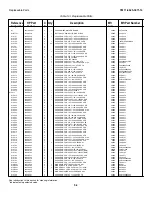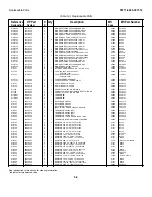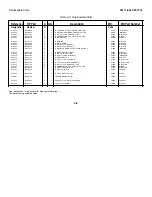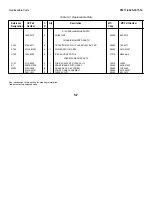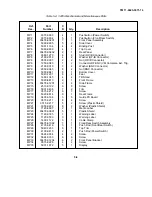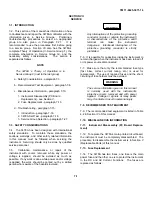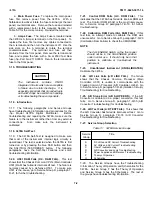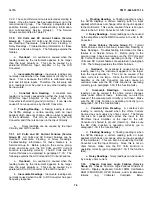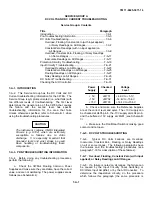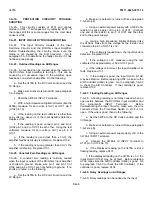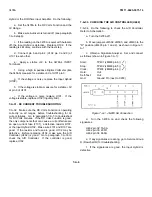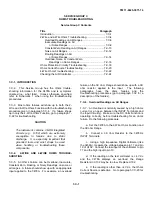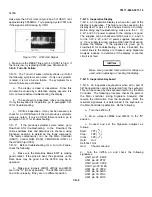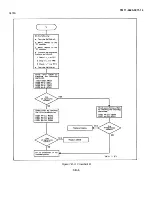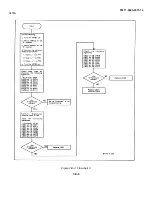
3478A
TM 11-6625-3071-14
7-29. The correct Service Group is selected according to
failure. Once the failure has been determined, go to the
recommended group. The following paragraphs lists
possible failures, general troubleshooting information,
and corresponding Service Group(s). The Service
Groups are also listed in Table 7-1.
7-30. DC Volts and DC Current Failure (Service
Group A). Typical DC Volts and DC Current Failures
are Overload, Inaccurate, Constant Zero, Floating, or
Noisy Readings. Troubleshooting information for these
failures is in Service Group A. The following explains the
failures.
a. Overload. An overload is caused when the
reading taken by the instrument appears to be larger
than the input actually is. This can be caused by a
saturated DC/Ohms Input Amplifier or by the A/D
Converter.
b. Inaccurate Readings. Inaccurate readings are
normally caused when the measurement circuitry is not
linear. This is because the 3478A is calibrated using
zero and full scale inputs. Therefore, the full scale and
zero readings must be good, but any other reading can
be inaccurate.
c. Constant Zero Reading. A constant zero
reading is normally caused when either the input to the
DC/Ohms Input Amplifier or the input to the A/D
Converter is shorted to ground (common). It can also be
caused if no runup is done by the A/D Converter.
d. Floating Reading. A floating reading is when
the 3478A displays a certain reading (with no input
applied) which does not change, after an input is applied
to the multimeter. This can be caused by the A/D
Converter and if there is an open in the Input Circuitry.
e. Noisy readings can be caused by the Input
Circuitry and A/D Converter.
7-31. AC Volts and AC Current Failures (Service
Group B). AC Volts and AC Current Failures can be
Overload, Inaccurate, Floating, or Noisy Readings.
Troubleshooting information for these failures is in
Service Group B. Before going to the service group,
check and make sure the DC Volts and DC Current
Function is operating correctly. The DC Volts and DC
Current failures are explained in paragraph 7-30. The
following explains the AC Volts and AC Current Failures.
a. Overload. An overload is caused when the
reading taken by the instrument appears to be larger
than the input actually is. This can be caused by a
saturated AC to DC Converter or the A/D Converter.
b. Inaccurate Readings. Inaccurate readings are
normally caused when the AC to DC Converter has poor
frequency response.
c. Floating Reading. A floating reading is when
the 3478A displays a certain reading (with no input
applied) which does not change, after an input is applied
to the multimeter. This can be caused if there is an open
circuit in the AC to DC Converter or A/D Converter.
d. Noisy Readings. Noisy readings can be caused
by the amplifiers and the RMS Converter in the AC to DC
Converter.
7-32. Ohms Failures (Service Group C). Typical
Ohms Failures can be Overload, Inaccurate, Floating, or
Noisy Readings. Troubleshooting information for these
failures is in Service Group C. Before going to the
service group, check and make sure the DC Volts and
DC Current Functions are operating correctly. The DC
Volts and DC Current failures are explained in paragraph
7-30. The following explains the Ohms Failures.
a. Overload. An overload is caused when the
reading taken by the instrument appears to be larger
than the input actually is. This can be caused if the
ohms current is too large. Since the DC/Ohms Input
Amplifier or the A/D Converter can also cause an
overload, make sure the DC Volts Function is operating
correctly (go to paragraph 7-30, if the function fails).
b. Inaccurate Readings. Inaccurate ohms
readings can be caused if the ohms current changes
value under different loads. Inaccuracy can also be
caused if the measurement circuitry is not linear. Make
sure the DC Volts Function is operating correctly (go to
paragraph 7-30, if the function fails).
c. Constant Zero Reading. A constant zero
reading is normally caused when the Ohms Current
Source does not supply any ohms current. The failure
can also be caused when either the input to the
DC/Ohms Input Amplifier or the input to the A/D
Converter is shorted to ground (common). Make sure
the DC Volts Function is operating correctly (go to
paragraph 7-30, if the function fails).
d. Floating Reading. A floating reading is when
the 3478A displays a certain reading (with no input
applied) which does not change, after an input is applied
to the multimeter. This can also be caused by the A/D
Converter and the Input Circuitry. Since this is not an
ohms failure, make sure the DC Volts Function is
operating correctly (go to paragraph 7-30, if the function
fails).
e. Noisy Readings. Noisy readings can be caused
by a noisy ohms current.
7-33. Chassis Common Logic Failures (Service
Group D). Chassis Common Logic Failures consists of
Turn-On, Display, Keyboard, Control ROM, Calibration
RAM (CMOS RAM), HP-IB Failures, and miscellaneous
failures (e.g. Voltmeter Complete, Exter-
7-3
Summary of Contents for 3478A
Page 2: ...TM 11 6625 3071 14 A ...
Page 4: ...TM 11 6625 3071 14 C D BLANK ...
Page 12: ...TM 11 6625 3071 14 Table 1 1 Specification 1 2 ...
Page 13: ...TM 11 6625 3071 14 Table 1 1 Specifications Cont 1 3 ...
Page 14: ...TM 11 6625 3071 14 Table 1 1 Specifications Cont 1 4 ...
Page 53: ...TM 11 6625 3071 14 1 ...
Page 54: ...TM 11 6625 3071 14 2 ...
Page 55: ...TM 11 6625 3071 14 3 ...
Page 56: ...TM 11 6625 3071 14 4 ...
Page 87: ...TM 11 6625 3071 14 3478A Figure 7 D 3 Flowchart B 7 D 5 ...
Page 88: ...TM 11 6625 3071 14 3478A Figure 7 D 4 Flowchart C 7 D 6 ...
Page 91: ...TM 11 6625 3071 14 3478A Figure 7 D 6 Flowchart D 7 D 9 ...
Page 111: ...TM 11 6625 3071 14 Figure 7 F 17 3478A Simplified Reference Circuitry 7 F 16 ...
Page 122: ...TM 11 6625 3071 14 Table A 2 A 2 HP IB Worksheet A 4 ...
Page 137: ...TM 11 6625 3071 14 Figure 7 D 2 Flow chart A 7 D 3 ...
Page 139: ...TM 11 6625 3071 14 Figure 7 G 2 3478A Block Diagram 7 G 3 ...
Page 140: ...TM 11 6625 3071 14 Component Locator for Input Circuitry and Ohms Current Source 7 G 4 ...
Page 141: ...TM 11 6625 3071 14 Figure 7 G 3 Input Circuitry and Ohms Current Source 7 G 5 ...
Page 142: ...TM 11 6625 3071 14 F G 6 ...
Page 143: ...TM 11 6625 3071 14 2 Figure 7 G 4 AC to DC Converter 7 G 7 ...
Page 144: ...TM 11 6625 3071 14 Component Locator for A D Converter and Control Logic 7 G 8 ...
Page 145: ...TM 11 6625 3071 14 3 Figure 7 G 5 A D Converter and Control Logic 7 G 9 ...
Page 146: ...TM 11 6625 3071 14 7 G 10 ...
Page 147: ...TM 11 6625 3071 14 4 Figure 7 G 6 Power Supplies 7 G 11 7 G 12 blank ...
Page 148: ......
Page 149: ...PIN NO 057444 ...






